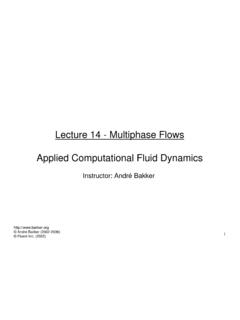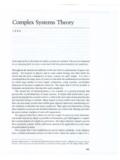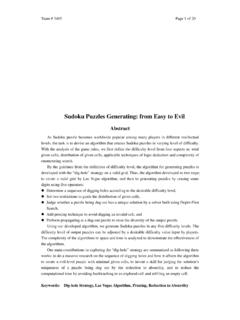Transcription of Approaches to Capacity Planning - analyticalQ
1 83 CHAPTER 3 Approaches to Capacity identified the scope of uncertainties in the previous chapter, we nowconsider how to model it. The modelling approach appeals favourably to anengineering-dominated, process-oriented industry. The operational research (OR)techniques that have been used to address the problems in Capacity Planning areknown for their applications to scheduling, resource allocation, routing, queuing,inventory control, and replacement problems commonly found in other capital-intensive, infrastructure-based industries such as telecommunications, military, andtransportation. We review these applications according to the extent to which theycapture the areas of uncertainties with respect to completeness and the manner inwhich they treat the types of uncertainties with respect to next three sections present the most commonly used techniques and theircapacity Planning applications.
2 These techniques are grouped according to theirprimary functionality of optimisation, simulation, and decision analysis, delineatingthe fundamental differences in modelling Approaches . Optimisation in section to linear programming, decomposition methods, dynamic programming, andstochastic programming. Simulation in section refers to system dynamics,scenario analysis, sensitivity analysis, and probabilistic risk analysis. Decisionanalysis in section refers to the use of decision trees and other decision-theoretic techniques. In each section, the techniques and respective applicationsare briefly introduced, with emphasis on their particular treatment of individual applications of techniques, we review applications based ontwo or more techniques, which we call model synthesis.
3 Here in section , the84same critique of areas and types of uncertainties is given. Modelling requirements,relating to technique functionality and limitations, are developed in the concludingsection ( ). Several proposals are made on the basis of this refers to the objective of minimising or maximising a function subjectto given constraints. Optimisation is usually understood in the deterministicsense, whence linear programming, decomposition methods, and dynamicprogramming readily apply. The next sub-sections present the optimisationtechniques in this order, with a final note on stochastic programming, which is aform of non-deterministic early as the 1950 s, Capacity Planning was perceived as that of meeting leastcost objectives within a highly constrained operational environment, and was firstmodelled with linear programming (Mass and Gibrat, 1957).
4 If the problembecomes too large to handle, decomposition methods (Vlahos, 1990) could be usedto breakdown the complexity and to speed up the computation. If viewed as amulti-staged problem in which decisions follow in sequence, dynamic programming(Borison, 1982) can be readily used as an alternative optimisation algorithm. Morerecently, stochastic programming has been used to model the deterministic andnon-deterministic ProgrammingTraditionally, Capacity expansion has been formulated as a least cost investmentproblem, utilising the algorithmic strengths of linear programming to minimise totalcost subject to fuel availability, demand, Capacity , and other objective cost function typically includes capital, fuel, and generation costs,over the entire Planning period.
5 The constraints typically include forecast demand,85plant availability, and other technical performance parameters. The Planning periodis usually split into sub-periods for modelling detail variations. The result is aninvestment schedule of different types of plants with varying sizes to come onstream and retire at different demand constraint is usually represented by a linear approximation to the loadduration curve (LDC). However, use of the LDC implies that costs and availabilityof supply depend only upon the magnitude of the load and not on the time at whichthe load occurs. This assumption is approximate for hydro systems and accuratefor thermal systems only if seasonal availabilities are taken into account.
6 Becausepower demand is highly variable throughout the day and year, the resulting LDCused in the constraint is an average their first trial in 1954, Electricit de France (EdF) developed a schematic linearprogramming model with only 4 constraints and 5 variables (Levy, 1989).Described in a classic paper by Mass and Gibrat (1957), this is the earliestapplication of LP to electricity Planning . Dantzig (1955) modelled the sameproblem with 70 constraints and 90 early LP models are discussed and classified in Anderson (1972) into so-called marginal analysis, simulation, and global models. In all cases, costminimisation is the main objective. The quantities demanded are assumed to beexogenous, and all formulations are deterministic.
7 The results must also satisfyengineering criteria, such as system stability, short-circuit performance, andreliability of supply. Allowances for uncertainty are given in the form of simplespare Capacity , which have to be expressed as a mean expected quantity because ofthe deterministic standard linear programming formulation in McNamara (1976) subjects theobjective of minimising the present value of a future stream of operating and86investment costs to meeting projected future demand. Projections of futurerevenues, costs, and capital requirements are made using a corporate financialplanning model. The LP model quickly determines the logical implications ofknown information and the impacts of variations in assumed trends.
8 The resultsare tested in the sensitivity analysis that typically follows an optimisation run. Thispost-optimal sensitivity analysis is not a substitute for uncertainty analysis as itdoes not sufficiently address the uncertainties of the accuracy and detail, such as to capture the non-linear effects of economiesof scale and merit ordering (load duration curves), impede upon the computationalspeed of linear programming. Nowadays, formulations with tens of thousands ofconstraints and variables, are common, Vlahos (1990), but they require othermethods of improving the speed. Non-linear programming is one way to overcomethis. However, when uncertainty is incorporated in these quadratic functions, themodel becomes computationally intractable (Maddala, 1980).
9 The complex, non-separable, but convex objective function of a non-linear programme cannot takeadvantage of what standard LP computer software can offer, namely,computational speed, standardisation of problem formulation, input and outputprocessors, and integer programming facilities. Furthermore, non-linearprogramming cannot be readily rewritten to address other issues, in the way thatLP can cope with allocation, scheduling, etc. In other words, a non-linearprogramming formulation is very problem-specific. One way to fit the result to anon-linear framework with uncertain parameters is through sensitivity analysis ofthe dual and slack variables.
10 But this only gauges the sensitivity of the outputresult to the input variables. Model validation is not the same as and Cherene s (1989) mixed-integer linear programme follows thepioneering work of Mass and Gibrat. The first part addresses the short-term87dispatching problem, which seeks the optimal utilisation of an existing array ofgeneration plants to meet short-term demand at minimal cost. The second partaddresses the long-term objective of optimising the expansion of electricitygeneration Capacity over a Planning horizon of several years. As the short runoperating cost of the dispatching problem depends on the investment decision ofcapacity expansion, it is necessary to evaluate both problems.




![arXiv:1301.3781v3 [cs.CL] 7 Sep 2013](/cache/preview/4/d/5/0/4/3/4/0/thumb-4d504340120163c0bdf3f4678d8d217f.jpg)

